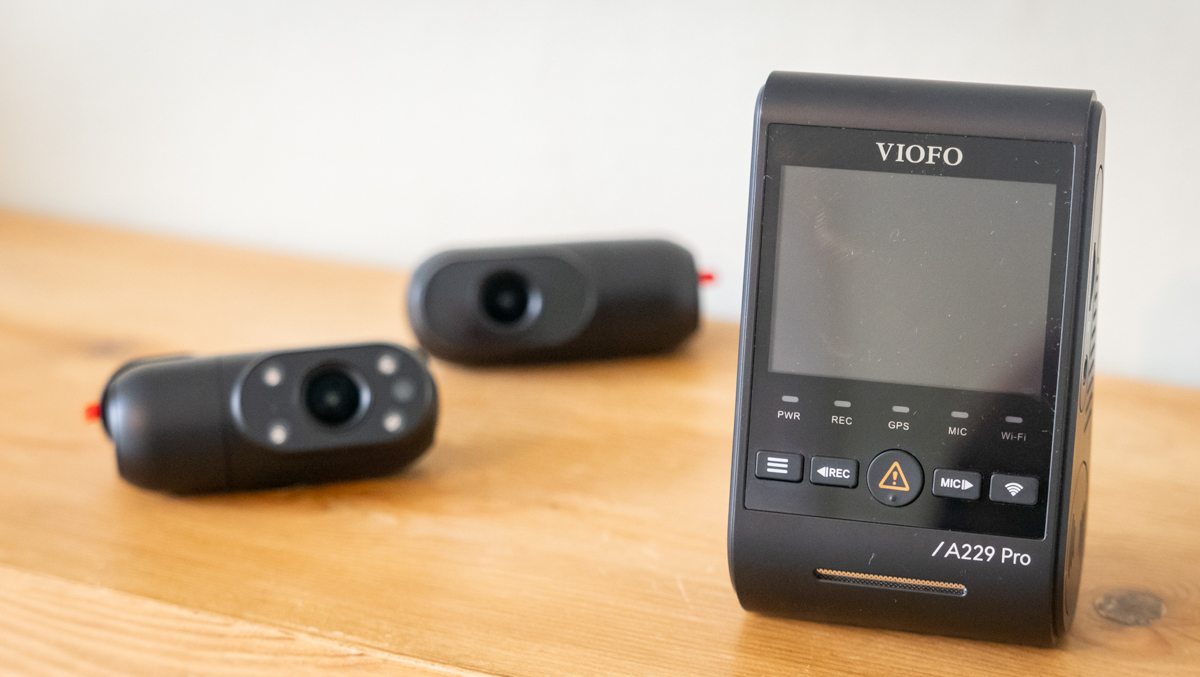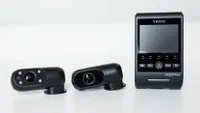Digital Camera World Verdict
A fantastic system that records in high resolution with HDR, produces impressive low-light footage, and is a breeze to install and set up. All those cables can get messy though, so pay for a professional installation if you can.
Pros
- +
High resolution for all three channels
- +
Good design
- +
Strong low-light performance
Cons
- -
Masses of cables can be messy
- -
Takes up extra windscreen space
- -
Interior dash cams not for everyone
Why you can trust Digital Camera World
If you were to build a three-channel dash cam system with the best possible specification, yet stick to a sensible price, this might just be it. It’s the latest flagship from Viofo and boasts 4K recording forwards, 2K recording to the rear, and a Full HD view with infrared night vision of the interior.
But what makes the dash cam stand out most are the new Sony Starvis 2 imaging sensors Viofo has fitted to both the forwards- and rear-facing cameras. These promise to improve low-light performance and reduce grain, making for clearer video recordings.
The three-camera kit includes the main unit, which attaches to the windscreen and has an integrated 2.4in display and GPS antenna. This connects with two cables to both the interior camera (which also attaches to the windscreen) and the rear camera, designed to be stuck to your rear screen. Other features include voice control, speedy 5GHz Wifi for fast video transfer to your smartphone, an included polarizing lens to help reduce dashboard reflections, and a parking mode that works with Viofo’s hardwiring kit (sold separately).
Specifications
Resolution: 2160p (front), 1440p (rear), 1080p (interior)
HDR: Yes
GPS: Yes
Voice control: Yes
The best camera deals, reviews, product advice, and unmissable photography news, direct to your inbox!
Field of view: 140 degrees (front), 160 (rear), 150 (interior)
Display: 2.4in
Battery: No
Parking mode: Yes (hardwiring required)
Design and handling
The A229 Pro isn’t the smallest dash cam on the market – it’s certainly no Garmin Mini 2 – but it’s still relatively compact, considering it has GPS, a 2.4in display, buttons and a 4K imaging sensor. The slightly chunkier design also means there’s plenty of room for heat to dissipate – a valid consideration, given the power needed to run three cameras at once, all at high resolution.
The front camera can be adjusted by about 70 degrees. It won’t work on a vehicle with a completely vertical windscreen, but for everything else it shouldn’t be a problem. The interior and rear cameras both rotate by a full 360 degrees, so they can be positioned however you like. The rear camera attaches with a long USB-C cable, while the interior camera uses a short proprietary cable. The main unit is then powered by an included 12V lighter socket adapter and another USB-C cable. Viofo sells a hardwiring kit as an optional extra.
I like how everything feels high quality. From the buttons to the rotating mechanism of the front camera, the A229 Pro feels like it was designed and built to last. That can’t always be said, especially of cheaper dash cam systems.
The windscreen mount has the footprint of a small matchbox and fixes to the screen with an adhesive pad, then slides securely into place on the back of the dash cam. Some dash cams take up less windscreen space, but it’s still a neat enough solution that should hide behind the central mirror of most vehicles. The other two cameras have far smaller adhesive pads, but cannot be removed from their screen mounts.
Performance
I’ve been impressed with the A229 Pro. The setup process is very easy and, while there is a smartphone app for transferring video over WiFi, you don’t have to use it. I like this flexibility, and how you don’t need to create a user account to get started.
That said, the three-camera nature of this system means there are a lot of cables to route around your car. I’d much rather the interior camera was integrated with the main, forward-facing unit, as it is with the Nextbase iQ. I have a small car with an equally compact windscreen, and found the main unit and interior camera, plus their cables, take up a fair bit of space. Factor in the rear camera too and you should seriously consider a professional installation, where the wires are neatly hidden behind interior panels (where possible).
The Viofo boots up quickly and starts recording right away, complete with a voice message to say how many channels are active. I don’t normally like dash cams with displays because of the distraction they can cause. But in this case it’s a decent-quality screen that shows the view of each camera, then shuts off to let you concentrate on the road ahead. A quick press of the middle button is all that’s needed to save footage manually (or it’ll also be saved if a collision is detected).
Video quality is impressive. The cameras are limited to 30 frames per second and I would perhaps have preferred 1440 and 60fps instead of 2160p and 30fps from the main camera. But the 4K footage is still great, with a nicely balanced exposure, a wide enough (140 degree) lens and plenty of sharpness to make key details, like vehicle number plates and street signs, legible. Night time performance is especially good, with a shocking lack of grainy noise after sunset.
The interior camera is also great, with its 1080p (Full HD) resolution. There’s more grain here, but still lots of detail and automatic infrared night vision for low-light recordings. I’d like to see a wider lens, as while 160 degrees is good, I would happily switch to 180 degrees and encounter some distortion as a compromise for a more complete view of the cabin and side windows.
The rear camera records at 1440p (2K) and its footage looks very similar to the front camera. It’s slightly wider, at 150 degrees, and captures enough detail to read nearby signs and vehicle plates.
Verdict
This really is a great system, and if you need a three-channel dash cam it’s hard to fault. The resolution is high, HDR is welcome, the Starvis 2 sensors do a great job of producing high-quality night time footage with less grain than some rivals, and the hardware feels well made.
I like how the setup process is super-simple (and doesn’t demand that you create a user account, or even download the Viofo app). I also like the use of USB-C cables, and the voice notifications are nicely implemented. This can be a messy setup though, with multiple cables creating a fair bit of clutter. Opt for a neater professional installation and you’ll have one of the best dash cam systems available today.
You might also like...
The Viofo A229 Plus is the less expensive version of the A229 Pro, with the key difference being that this has a lower-quality 2K front camera. It is available as either a 2-camera or a three-camera kit.
Read more guides:
Best dash cams
Best front and rear dash cams
Best Uber dash cams
Best budget dash cams
Best backup camera
Alistair has been a journalist since 2011 and used to be Deputy Technology Editor at IBTimes in London. His specialist tech subjects include smart home gadgets, phones, wearables, tablets and dashcams. He is the host of The AutoChat Podcast.










